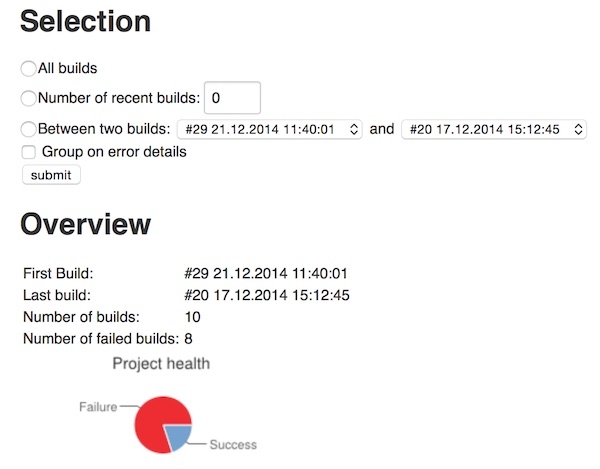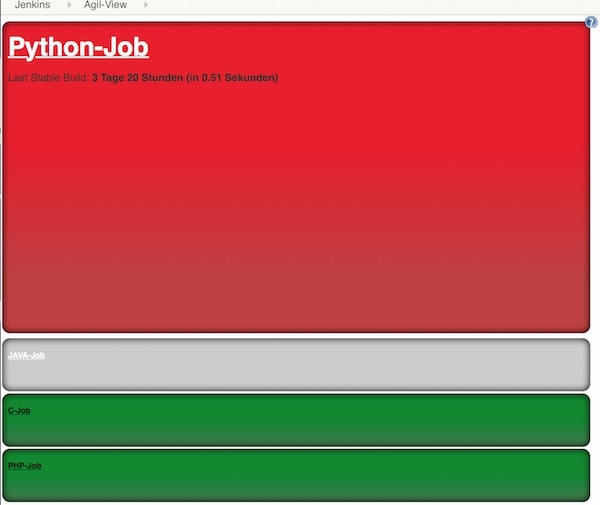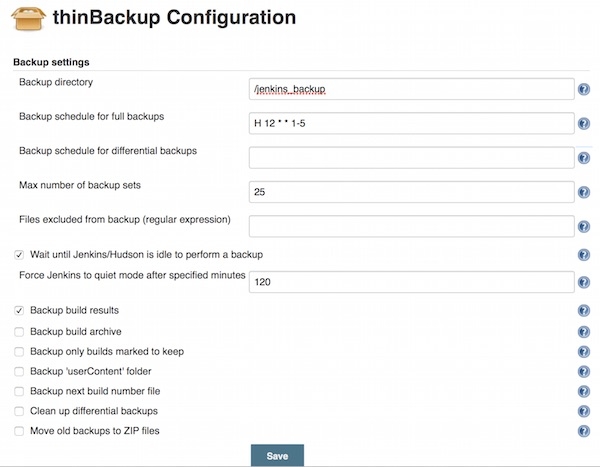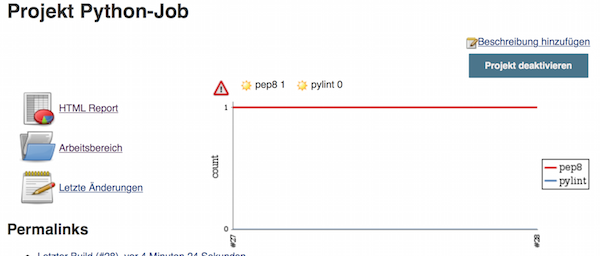Preparation
Search and install the “Project Health Report Plugin”

Usage
After successful installation every job has a new menu item. After press this icon you can define which builds should be visible in report.

Preparation
Search and install the “Project Health Report Plugin”

Usage
After successful installation every job has a new menu item. After press this icon you can define which builds should be visible in report.

Preparation
Search and install the “Radiator View” plugin.

Configuration
After installation create a new view, similar to configuring the more conventional list views.

Now select all desired jobs and press “Save” button.

The build radiator view displays a box for each build with the job name and some other details, depending on build steps and test methods.
Preparation
Create a new folder with read/write permission for Jenkins.
Example
# create directory
$ mkdir backup_jenkins
# change user
$ chown jenkins:jenkins backup_jenkins/Now install the Jenkins Plugin “ThinBackup”.

Backup configuration
After installation and restart, you can start with backup configuration “Manage Jenkins > ThinBackup > Settings”. For Backup directory insert the path for directory that you created. Complete the configuration by your needs and press “Save” button.

Backup
Now you could wait for 1st automated backup or press the “Backup Now” button “Manage Jenkins > ThinBackup”.
Restore
For restore simply select Restore “Manage Jenkins > ThinBackup”. Select backup from list and press “Restore” button.
RATS – Rough Auditing Tool for Security. Open-Source software to scan C, C++, Perl, PHP and Python code. For other languages see Fortify.
Installation
# CentOS
$ yum install rats
# Debian
$ aptitude install rats
# wget
$ wget http://www.fortify.com/servlet/download/public/rats-2.3.tar.gz
# curl
$ curl --remote-name http://www.fortify.com/servlet/download/public/rats-2.3.tar.gz
# extract
$ tar xfz rats-2.3.tar.gz
# change directory
$ cd rats-2.3
# compile
$ ./configure && make && sudo make installExecute RATS
# Simple run
$ rats --resultsonly <directory>
# Advanced run
$ rats --quiet --xml -w 3 <directory>In this tutorial i show, how you as a tester can create a very basic python code analysis and documentation job in your build server.
Preparation
Install needed python modules
$ pip install pylint
$ pip install pep8
$ pip install epydocInstall needed Jenkins plugins
Create a Free Style job
Create a new job with your requirements (e.g. Project name, Source-Code Management, etc.). Now insert commands “Build > Execute Shell”.
pep8 ${WORKSPACE}/<module|file> > pep8_report.txt
echo "pep8 complete"
pylint -f parseable ${WORKSPACE}/<module|file> | tee pylint_report.txt
echo "pylint complete"
[ -d ${WORKSPACE}/API ] && rm -fr ${WORKSPACE}/API
epydoc ${WORKSPACE}/<module|file> --html --name 'My Project API' -o ${WORKSPACE}/API/
echo "epydoc complete"Add the Post-Build-Action – Report Violations and Publish HTML reports. On violations insert the pep8 (pep8_report.txt) and pylint (pylint_report.txt) values. On Publish HTML reports add the folder API.
After running the build, the screen should look like this:
